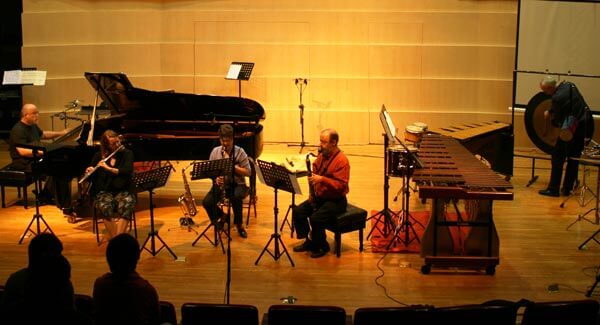 Kansas City’s major classical music ensembles have focused on melding visual and musical art for the 2012-2013 season. The Kansas City Ballet collaborated with the Kansas City Symphony and Chorus to stage Orff’s Carmina Burana last fall. In February, the Symphony premiered a work by Adam Schoenberg titled Picture Studies, a 21st century Pictures at an Exhibition inspired by works displayed at the local Nelson-Atkins Museum of Art. It was the newEar Contemporary Music Ensemble‘s turn on March 1-2, 2013, to explore musical, visual, and also literary connections with a concert titled “Strangely Familiar.”
Kansas City’s major classical music ensembles have focused on melding visual and musical art for the 2012-2013 season. The Kansas City Ballet collaborated with the Kansas City Symphony and Chorus to stage Orff’s Carmina Burana last fall. In February, the Symphony premiered a work by Adam Schoenberg titled Picture Studies, a 21st century Pictures at an Exhibition inspired by works displayed at the local Nelson-Atkins Museum of Art. It was the newEar Contemporary Music Ensemble‘s turn on March 1-2, 2013, to explore musical, visual, and also literary connections with a concert titled “Strangely Familiar.”
The first half of the event, which consisted of shorter works for solo instruments and duets showcasing the virtuosity of this remarkable group, was held in newEar’s usual concert hall setting at the All Souls’ Unitarian Univeralist Church. For the second half, the audience was invited across the street to the Kemper Museum of Contemporary Art for the world premiere of a commissioned work, The Martian Chronicles by Paul Rudy. Unfortunately, it was not so successful.
Anna Clyne‘s fits + starts from 2003 is scored for amplified cello and electronics. The live cello echos and comments on the predominantly pizzicato ostinato from the distorted cello electronics. A climactic central section is almost hyper-romantic with its passionate cadenza sometimes pushing the accompaniment to the side, then joining in dialog with the soaring cello. Soloist Lawrence Figg clearly loved and made a strong case for the work, one of the most effective pieces on the program.
Robert Pherigo performed an early work by Thomas Adès, Still Sorrowing (1992) for prepared piano. Still Sorrowing begins quietly and tentatively in the highest registers, a person rummaging through a ruined landscape perhaps, finding things strange yet familiar. The prepared middle register provides a sobering and muffled percussive accompaniment to the upper register’s wanderings. As Pherigo removed some of the piano preparations and the lower register made its debut, the piece drove towards an emotional climax only to slink into the gloom once again. Pherigo was in total command of this meditative, chilling, but ultimately lyrical piece.
Metamorphosis II – Chant of Snow River, written in 2003 by Malaysian composer Chong Kee Yong for flute (Lyra Pherigo) and percussion (Mark Lowry) duo, was more successful than first anticipated. At an advertised 11 minutes, a work for breathy flute (plus alto and piccolo) and gentle pitched percussion might quickly get tedious. But immediately the work revealed its intimate and lyrical side. The duo conversed both through their instruments and with shouts and vocal exclamations (à la George Crumb) as the flutist wandered from station to station around the auditorium, even joining in with some percussive gestures. A more animated and rhythmic percussion interlude on steel drums and gongs provided interesting contrast to the more static passages. The once feared 11 minutes simply flew by as we all became engrossed in this musical conversation.

Composer Lee Hyla (photo credit: Jane Lackey)
Lee Hyla‘s We Speak Etruscan (1992) closed the first half of the concert. Scored for an odd duo of baritone saxophone and bass clarinet, We Speak Etruscan is heavily jazz and bebop influenced. Like its preposterous title, this is tongue in cheek music; the jazz sounds seemed more suited for a party of cartoon moose. I kept thinking of Bullwinkle the Moose while listening. Maybe it was the cascade of low register blurts and purposefully clumsy rhythms. But this was another piece that was more satisfying than first imagined.
Paul Rudy‘s much hyped Martian Chronicles, based on Ray Bradbury’s famous science fiction stories, was sadly a major letdown, partially due to the music and more than partly due to the venue. Musically it is 25 minutes of wailing saxophone, with interludes by a “bastard horn” made from a flute and a bamboo sax, accompanied by a sonic goo of noises from outer space. While ably played by local guest saxophonist Mark Southerland, the music really goes nowhere and only hints at the horror and devastation of a ruined earth. I wished for more visceral anarchy and terror. The wailing and gnashing from the horns might portray the frustration with humanity that permeates Bradbury’s work, but that alone could not sustain the 25 minute musical work.
The Kemper Museum venue did not help matters. Presented in the spacious, high-ceilinged lobby, the music did not interact with the space at all well. The artwork was of little relevance to the music, and the acoustics were problematic at best. The mixed media outer space sounds, a melange of the bleeps, buzzes, and pulses of stars and satellites, were mostly inaudible from my vantage. The newEar ensemble might as well been back across the street as they (except for percussion and flute) were also inaudible. Perhaps if one could adequately hear the horns’ interactions with the electronics and the ensemble the piece might work. As it stands “The Martian Chronicles” is a vehicle that needs some fine tuning.
–
Don Clark is a classical music enthusiast, free lance concert reviewer and blogger. Follow him on Twitter: @Donaldopato.























